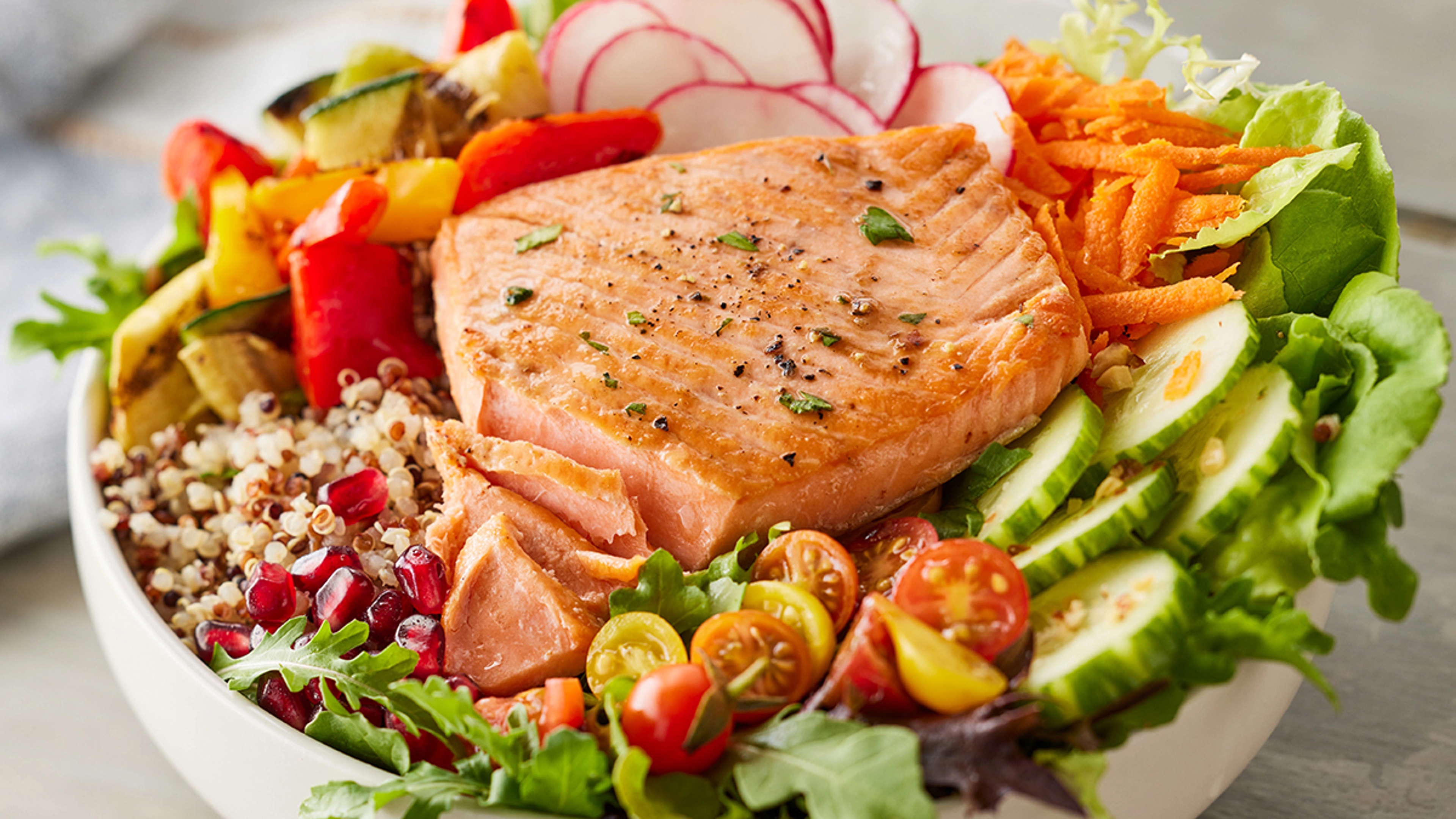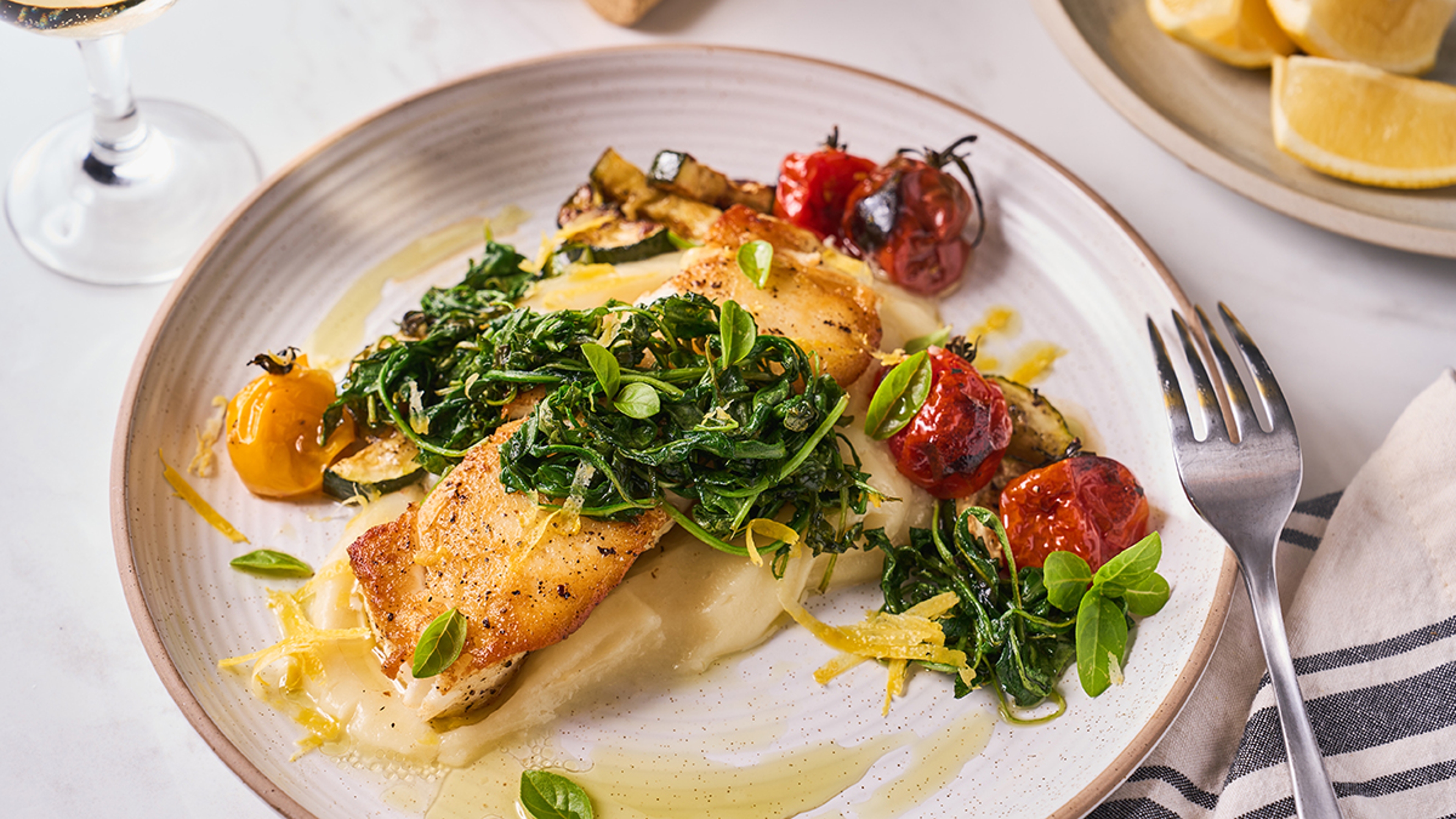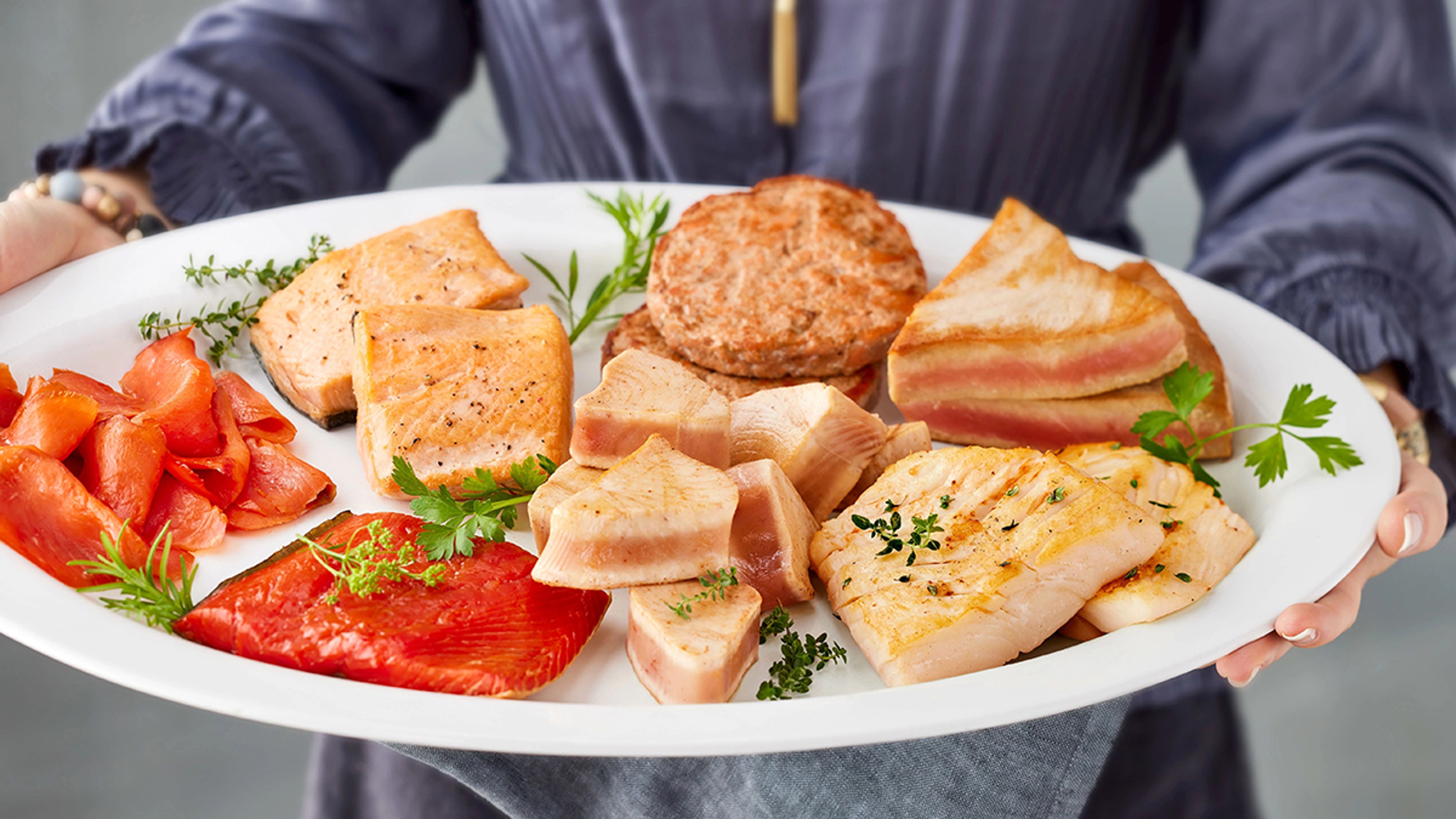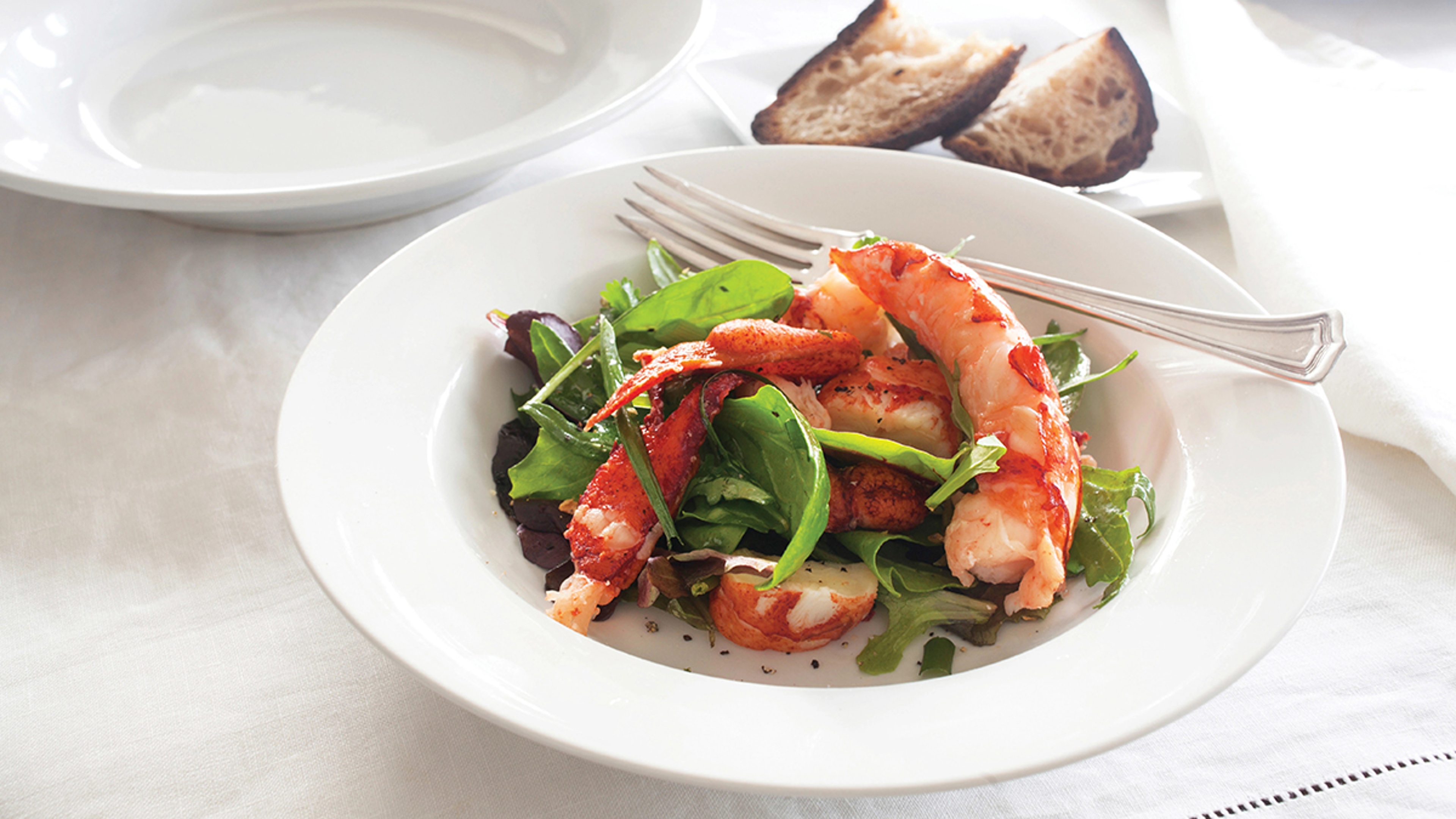Enough With Omega-3s. What Else Do Fish Offer?
Apparently, a lot of other nutrients.
May 03, 2024
We forgive you for automatically thinking of omega-3 fatty acids when you think of fish — mainly because that seems to be all folks talk about when it comes to the benefits of eating fish.
Yes, omega-3s are a good thing, and sea creatures have varying levels of them, but fish are also chock full of other healthy nutrients.
Here’s the lowdown on the non-omega-3-related health benefits that many common types of fish offer.
Salmon
Forget what we told you about omega-3s, just for a moment. Salmon is a prime landlord for omega, which, combined here with potassium, helps reduce artery inflammation, blood pressure, and cholesterol levels, and, thus, heart disease. (Omega-3 bonus: shinier hair!)
Salmon also boasts lots of vitamin D. A 3.5-ounce serving of wild-caught salmon offers up to 700 international units (IU) — topping the USDA recommended daily allowance of 600 IU. So, if you ate just one serving of salmon a day, you’d be doing wonders for your immune system, bones, and muscles.

Halibut
While this flatfish does sport some omega-3 (250 to 500 milligrams), it doesn’t measure up to that of salmon. But that’s OK, because halibut features other benefits.
Protein, for instance, figures prominently: A 6-ounce serving of halibut delivers a weighty 38 grams of the stuff. That same serving size also comes with 91% of the recommended daily allowance of vitamin B12, 135% of selenium, 71% of niacin, 40% of magnesium, and 37% of vitamin B6.
Cod
A fish so prominent in Massachusetts, an explorer named a whole Cape after it!
This flaky white fish with a delicate flavor has significant health benefits, delivering a wallop of protein and little fat. A 3-ounce serving of cod provides 19 grams of protein and roughly 1 gram of fat, while containing only 85 to 90 calories.
Cod delivers somewhat in the omega-3 department too (less than 250 milligrams), though not nearly as much as fattier fish like salmon. It is, though, a significant source of B vitamins, which help your body mine the most nutrients and energy from food.
Chilean Sea Bass
First, know that Chilean sea bass isn’t actually bass at all (bass being a generic name tacked onto a number of fish) but rather a Patagonian Toothfish. The name was changed to better match the fish’s gourmet quality — a rich, buttery fish with a flavor comparable to that of cod.
Like cod, Chilean sea bass is protein dense, low in calories, omega-3 friendly (265 grams per serving size), and rich in vitamin B. It also has a high level of selenium, an essential mineral that promotes thyroid function and antioxidant defense.
Warning, though: Chilean sea bass also contains significant mercury, so you should limit your intake to a few times per month.

Sablefish
In the same way Chilean sea bass is like cod, sablefish (also known as black cod and butterfish) is like Chilean sea bass in that when it is cooked, it boasts a flaky texture.
Otherwise, it’s a very fatty fish — tasty, rich, and buttery (hence, the butterfish pseudonym), and offering high levels of omega-3 (more than 1,000 milligrams per serving, on par with salmon). Other benefits: plenty of vitamins D and B12, and selenium.
Tuna
Perhaps one of the beefiest fish, tuna is sold as steaks for a reason: It has a delicate, meaty texture and lacks any fishy smell or taste.
Tuna belongs to the Thunnini tribe, which comprises 15 different species — at least some of which you’ve heard of, including albacore, bluefin, Atlantic, Pacific, and yellowfin. Despite the variety, they all have some nutritional commonalities. Tuna is another omega-3 powerhouse (the bluefin variety delivers roughly 1.6 grams per serving). Plus, it’s high in protein (19.8 grams) and low in calories, offers high levels of vitamin D (193 IUs), and provides a good-sized serving of vitamin B6 (0.837 milligrams), iron (0.867 milligrams), potassium, and selenium.
Haddock
A member of the cod family — though with a slightly sweeter taste and smaller flakes — haddock is mild flavored and firm, yet tender. You can buy the fish fresh, smoked, frozen, dried, or canned.
What haddock lacks in omega-3s (levels are minimal) it makes up for in other health benefits: It’s high in protein (31.5 grams per serving), low in fat, contains no carbs, and offers substantial amounts of niacin, vitamin B12, phosphorus, and selenium.
Lingcod
Lingcod isn’t a cod at all but rather a greenling, a carnivorous fish, which, like the family beagle, eats just about anything, including (unlike the family beagle) other lingcod. Like cod (and halibut), though, this lean, velvety white fish sports a mild flavor.
Healthwise, lingcod is an all-around solid fish. It’s an upstanding member of the omega-3 club and, like many fish here, boasts plenty of protein as well as vitamin B12, selenium, and niacin.
Petrale Sole
Yet another imposter of the sea, the petrale sole — despite its name — isn’t a true sole fish but rather a right-eyed flounder (a designation, no doubt, made by some marine optometrist*). Mild and sweet with a nutty finish, the petrale sole sports a small, firm-flake texture.
Petrale sole is somewhat unique among the fish profiled here in that it offers a decent amount of calcium: A 6-ounce piece serves up 4% of your daily value of the mineral. Like many others, though, it’s a low-fat source of protein — at roughly 22 grams for a 3-ounce serving, it aligns with ground beef.
*Actually, this type of fish gets the right-eyed designation because both eyes rest on its right side.

Scallops
From the mollusk phylum, which brings us snails, clams, and mussels (more on that last one below), we get scallops. These have quite the distinct flavor among marine dishes, pushing them into the seafood delicacy category. (Just don’t overcook them; doing so makes them rubbery and tough to chew.)
More than just good for your taste buds, scallops are good for you. They’re rich in omega-3s, low in fat, and high in protein. They also are a good source of iron, zinc, potassium, selenium, and B12.
True, like all shellfish, scallops and shrimp (see below) contain a good smattering of cholesterol. But, Healthline notes, shellfish lack saturated fats and are great sources of lean protein for people who eat animal products, and provide essential omega-3 fatty acids the body can’t make on its own.
Shrimp
Next time you mingle at some fête, don’t feel guilty about gorging on the cocktail shrimp — it’s a much healthier alternative to potato chips (see above).
Other benefits: Shrimp contain astaxanthin, an antioxidant that not only gives the crustacean its pinkish-organish hue but can reduce inflammation. Shrimp also have iodine and selenium, which are good for thyroid health, and immune system-boosting vitamin E and zinc.
Crab
Sure, being crabby means you’re grouchy — a reference to the often feisty nature of these creatures — but eating one of these crustaceans should actually make you chipper, given their delicate, sweet, and mineral-salt flavor…and health advantages.
Another protein powerhouse, crab also offers selenium and vitamin B2, the latter aiding in the production of steroids (which our bodies use to produce hormones, for instance) and red blood cells. The flesh of this shellfish also offers phosphorus, an important mineral for bone health, and copper, which helps with iron absorption.
Mussels
A few years back, mussels were declared a superfood. And it’s easy to see why.
This Mollusca is oozing with zinc, with 20 mussels typically providing half your daily need. (Zinc, as you may know, boosts immune function.) Other benefits: You get close to 1.5 times your daily requirement of selenium and one-third of your daily iron needs. Also: vitamins B2 and B12, phosphorus, copper, iodine, and, of course, omega-3 fats.

Lobster
What’s so great about this gourmet delicacy that allows it to command prices akin to a small mortgage? Well, of course, there’s the taste: buttery, with a nice balance of sweet and “the sea” (salty). Plus, this shellfish sports a tender, meaty texture.
Lobster is a bit high in sodium and cholesterol, but its pros far outweigh its cons. These crustaceans offer plenty of protein and potassium, as well as, based on a 100-gram serving, 67% of your daily recommended intake of iodine — a proven thyroid-function booster.
Calamari
Sure, you love it fried (or sauteed or grilled), but would you love it less if you knew “calamari” is just a more culinary name for squid? We thought not.
Here’s another calamari fun fact: Unlike many other marine members cited here, squid boasts choline, a brain-function booster and inflammation reducer that’s even good for your liver. This mollusk also naturally offers some omega-3s (though only about half as much fatty fish like salmon) and vitamin B12 (109% of your daily value).
Mackerel
Here’s a fish so loaded with omega-3 that it’s a disadvantage. Unless you eat mackerel fresh from the sea, all its oils give it that fishy smell and taste. Otherwise, this soft, moist, and flaky fish has a slightly sweet and salty taste.
Mackerel — all 30-plus types — is considered one of the most nutritious fishes, offering plenty of protein, all the good B vitamins (2, 3, 6, and 12), and vitamin D. Plus, its skin is like a quarry, bursting with minerals like selenium, copper, and iodine.
Sardines
Sardines (along with the subsequent entry) are among the fishiest of fishes, reeking with traits that make non-fish lovers so picky about which marine life they’ll eat. Yes, it falls into the oily fish (rather than white fish) category and, thus, boasts a “fishy” smell and mild fish taste.
But if that’s cool with you, you’ll benefit from its offerings: plenty of vitamins D and B12, along with selenium, calcium, and phosphorus. Plus, you’ll get iron, potassium, zinc, and choline. And guess what: The TODAY show declared sardines a hip fish!
Anchovies
You can almost think of sardines — another oily fish with an even stronger taste — to be training wheels for anchovies. The main difference: Sardines are preserved in olive oil so they taste milder; anchovies are more often salt cured.
The anchovy also has a similar nutritional profile to the sardine, though it offers more protein, iron, zinc, and niacin, whereas sardines win when it comes to vitamins B12 and D.
It’s what’s on the inside that counts
As noted above, fish and seafood contain incredible concentrations of essential vitamins and minerals. Here’s a basic rundown of all their nutritional blessings and what each one can do for you.
Vitamin A Plays a major role in the health of your teeth, skin, and eyes. It’s also essential during pregnancy and breastfeeding.
Vitamin B3 Also called niacin, vitamin B3 promotes cell production, supports nerve function, and helps with digestion. It also helps convert calories into energy.
Vitamin B12 This vitamin is a strength and energy booster, which helps prevent anemia, fatigue, and depression, and improves overall cognitive function.
Vitamin D Salmon is one of the few natural food sources that provides vitamin D, which most Americans lack. It plays a critical role in the absorption of calcium for strong bones and teeth, and supports the brain, nervous system, and muscle function, while also boosting immunity.
Tryptophan This essential amino acid is used to make proteins. It also helps produce serotonin and melatonin to regulate mood and aid sleep.
Iron This is a critical mineral that helps create hemoglobin, the protein in red blood cells. Iron also helps move oxygen from the lungs to the body’s other tissue, and supports healing and growth.
Zinc This trace mineral aids in immunity function, cell growth, and wound repair.
Potassium Most Americans are deficient in this mineral, which helps regulate blood pressure and offset problems with high sodium intake.
Magnesium This mineral is involved in over 600 cellular activities and drives muscle contraction. It also helps manufacture DNA.
Phosphorus Ensuring strong bones and teeth, this mineral also plays a key role in developing DNA and RNA, the conversion of calories and oxygen into energy, and the transmission of nerve signals.
Iodine This mineral is chiefly responsible for thyroid regulation and cognitive function. It also plays a major role in the neurological development of fetuses.
Selenium This essential mineral supports thyroid and metabolism function. It’s also an antioxidant that helps counter free radical damage.
Additional reporting by Michael Q. Bullerdick







